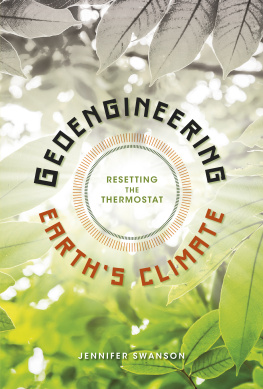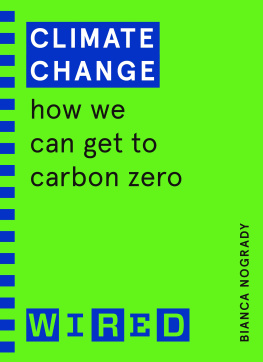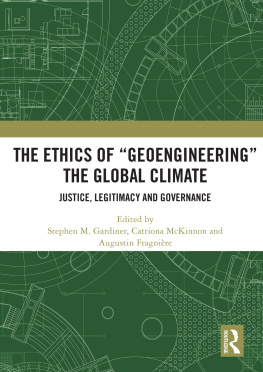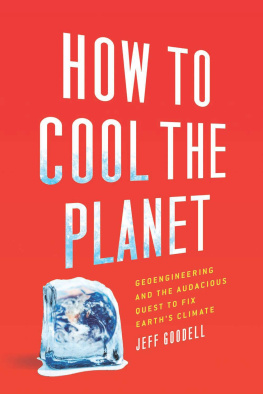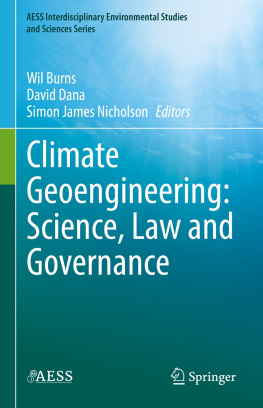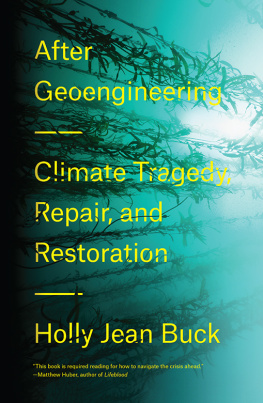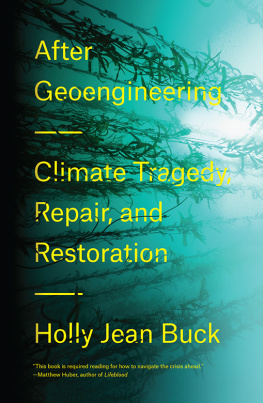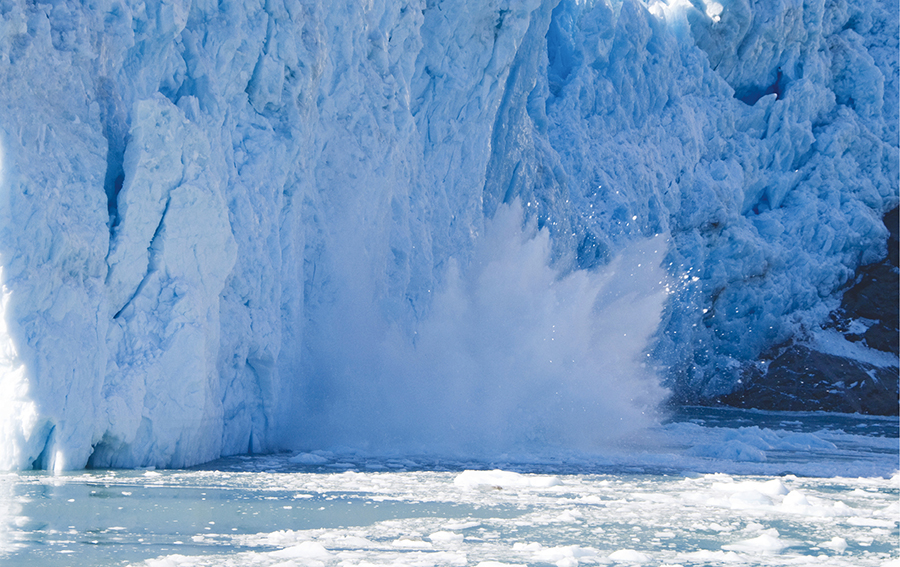To the scientists and engineers who work so hard to keep our planet healthy. Thank you for all you do.
Text copyright 2018 by Lerner Publishing Group, Inc.
All rights reserved. International copyright secured. No part of this book may be reproduced, stored in a retrieval system, or transmitted in any form or by any meanselectronic, mechanical, photocopying, recording, or otherwisewithout the prior written permission of Lerner Publishing Group, Inc., except for the inclusion of brief quotations in an acknowledged review.
Twenty-First Century Books
A division of Lerner Publishing Group, Inc.
241 First Avenue North
Minneapolis, MN 55401 USA
For reading levels and more information, look up this title at www.lernerbooks.com.
Main body text set in Adobe Garamond Pro 11/15
Typeface provided by Adobe Systems.
Library of Congress Cataloging-in-Publication Data
Names: Swanson, Jennifer.
Title: Geoengineering Earths climate : resetting the thermostat / Jennifer Swanson.
Description: Minneapolis : Twenty-First Century Books, [2018] | Audience: Age 1318. | Audience: Grade 9 to 12. | Includes bibliographical references and index.
Identifiers: LCCN 2016059722 (print) | LCCN 2017000330 (ebook) | ISBN 9781512415698 (lb : alk. paper) | ISBN 9781512448641 (eb pdf)
Subjects: LCSH: Environmental engineering. | Climate change mitigation. | Climatic changes. | Global warming. | Carbon sequestration.
Classification: LCC TD171.9 .S93 2018 (print) | LCC TD171.9 (ebook) | DDC 551.68dc23
LC record available at https://lccn.loc.gov/2016059722
Manufactured in the United States of America
1-39926-21392-1/16/2017
9781512467864 mobi
9781512467871 ePub
9781512467888 ePub
Contents
One
An Abrupt Change in Climate
Two
Time to Get Serious
Three
Capturing Carbon
Four
Rock and Roll
Five
Carbon in the Water
Six
Shading the Planet
Seven
Geoengineering Our Future
Authors Note
Geoengineering is a fascinating field of study. Some say it is the most important topic of our time. With the effects of climate change creeping into every aspect of our planet, it is easy to see why.
While many geoengineering ideas are controversial, the fact that we are discussing them and researching them shows a collective spirit and one that is interested in resetting Earths thermostat. I encourage everyone who reads this book to continue learning about this controversial topic. Research. Theorize. Engage in debate. Devise your own ideas if you think you have one that might work. It is the job of the entire planet to solve this issue.
I would also like to thank those leaders in the field who took time out of their busy schedules to speak with me about their projects. The list includes
Dr. Peter Eisenberger, Global Thermostat
Dr. Clare Heyward, University of Warwick
Dr. Richard Houghton, Woods Hole Research Center
Dr. David Keith, Harvard University
Dr. Piers Forster, University of Leeds
Dr. John Sterman, Massachusetts Institute of Technology
They were all happy to share their beliefs and passion for their subjects with me and, by extension, with the readers of this book. I am very grateful to them.
Jennifer Swanson
One
An Abrupt Change in Climate
Rising seas. Flooded islands. Catastrophic droughts, tornadoes, and hurricanes. Scientists say that these trends, which have been increasing in the twenty-first century, are caused by climate change, created by the warming of Earth. Most scientists also say that humans have caused climate change by burning fossil fuels (coal, petroleum, and natural gas), which release heat-trapping gases into the atmosphere. As levels of these gases increase, the planet grows warmer. The higher temperatures have led to extreme weather events. Most experts agree that if humans dont take action to prevent Earth from warming further, the climate will undergo even more drastic changes. And these will ultimately affect every living thing on Earth. What can humans do to counteract climate change?
Some engineers propose using geoengineering to tackle the problem. The prefix geo means relating to Earth, so geoengineering means engineering Earth. A more formal definition of geoengineering is the active transformation of Earths climate through human interventionor using technology to reverse the effects of climate change. Sounds good, right? Maybe so. But geoengineering is one of the most complex and controversial topics in the world. Messing with Earths climate is a big deal and could have lasting consequences, both positive and negative.
Cra-ck!
Tiny cracks have appeared in a glacier (a large body of moving ice) along Evigheds Fjord in western Greenland. In the past, ice and snow completely covered the towering mountains that surround the fjord. But in the twenty-first century, dense rock is visible underneath the ice. The extremely cold weather that allows Greenlands coastal mountains to remain covered in ice and snow year-round has changed. Warmer temperatures in Earths atmosphere are melting the top of the glacier, sending rivulets of ice water into the ocean. Warming waters of the North Atlantic Ocean are melting the glacier from the bottom as well.
Chunks of ice break off a glacier on the southeastern coast of Greenland and fall into the Denmark Strait. Warmer air and water temperatures are melting ice in Earths polar regions, causing sea levels to rise.
The melting glacier on the Evigheds Fjord is part of a much larger formation called an ice sheet. Earth has two major ice sheetsone on Greenland and one on Antarctica. Measuring more than 660,000 square miles (1.7 million square kilometers), Greenlands ice sheet is approximately the size of Texas. On average, the ice sheet is 1 mile (1.6 km) deep. Its greatest depth is 3 miles (4.8 km). If it were to melt entirely, the total amount of water it contains would raise the oceans by about 23 feet (7 meters). The rising waters would flood the coasts of every country on the planet and submerge many inhabited islands.
While the probability of the entire Greenland ice sheet melting is slim, climatologists (scientists who study Earths climate) note that Greenland is shedding more ice during summer than it regains from snowfall in winter. The US National Aeronautics and Space Administration (NASA) reports that Greenlands ice sheet is losing about 31 billion tons (28 billion metric tons) of ice annually. Some of the melting ice evaporates (turns into water vapor) or stays on the land, but most of it goes directly into the ocean. And studies show that the melting on Greenland is increasing every year.
NASA uses satellites to measure the depth of Earths oceans. The agency has noticed a definite rise in ocean levels over the last century, with an average yearly rise of about 0.13 inches (3.3 millimeters). While that may seem small, it adds up to a 4- to 8-inch (10- to 20-centimeter) rise over the past one hundred years. If that water were lying in the street, it could flow over curbs and into houses. If you were standing next to the ocean, the rising water would cover your legs to mid-calf. Imagine that much water flooding the entire world. And if the ice sheets continue to melt, the water levels will only get higher.

